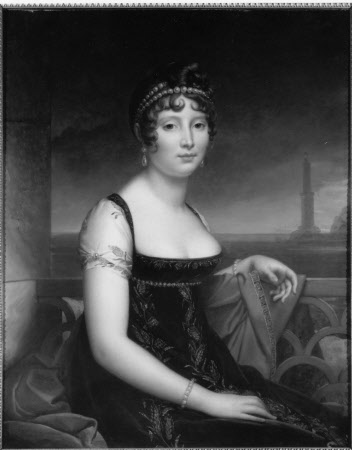Caroline-Marie Bonaparte, Caroline Murat, Queen of Naples (1782-1839)
Louis Ducis (Versailles 1775 - Paris 1847)
Category
Art / Oil paintings
Date
circa 1810
Materials
Oil on canvas
Measurements
825 x 635 mm (32 1/2 x 25 in)
Place of origin
Naples
Order this imageCollection
Attingham Park, Shropshire
NT 608957
Caption
The sitter was the sister of Napoleon Bonaparte, who in 1800/02 married Joachim Murat (1767-1815), who became King of Naples in 1808. After her husband was court-martialled and shot in 1815, the crown returned to Ferdinand IV. She was forced to leave the country, and styled herself as the Countess of Lipona. She settled in Trieste, North Italy, and married General MacDonald, one of Murat's ex-ministers. The picture was bought by Thomas Henry Noel-Hill, 8th Lord Berwick (1877-1949) at the sale of the Empress Eugenie’s pictures, at Christie’s in 1927. It was catalogued as by Vigée Lebrun, and although close to the work of Gerard, it is more likely to be by Louis Ducis, who was court artist to the Murats in Naples.
Summary
Oil painting on canvas, Caroline-Marie Bonaparte, Caroline Murat, Queen of Naples (1782-1839) by Louis Ducis (Versailles 1775 – Paris 1847), previously attributed to Baron François Gérard, circa 1810. A three-quarter-length portrait of the Emperor Napolean's sister, seated to right, head facing, her left arm resting on a balustrade. In the background is the sea with a lighthouse. She is wearing a row of pearls in her hair and black dress embroidered in gold thread. Born Maria Annunziata Carolina Bonaparte in Ajaccio, Corsica, France, she was the daughter of Carlo Maria Bonaparte and Maria Letizia Ramolino, and sister of Napoleon Bonaparte. She married, firstly, Joachim Murat, King of Naples (1867-1815), on 20 January 1800 with whom she had four children. After her husband's execution for treason against his successor, King Ferdinand IV of Naples, she subsequently married Francesco Macdonald (1777–1837) who had been Minister of War of the Kingdom of Naples in 1814 and 1815, in 1830. She lived in Florence until her death in 1839. When the 8th Lord Berwick purchased this portrait in 1927, he may have been inspired by the fact that his ancestor, William Noel-Hill, 3rd Lord Berwick and Minister Plenipotentiary to the Court of the Two Sicilies, resided from 1824 in Caroline Murat's former Neapolitan residence, the Palazzo Belvedere. The ceramics and ormolu that the 3rd Lord Berwick acquired while living at the Palazzo Belvedere, along with the pictures he collected throughout his time in Italy now form a significant part of the furnishings and character of Attingham Park.
Provenance
Bought by 8th Lord Berwick at Christie's sale of the Empress Eugenie's pictures 1927, catalogued as by Vigée le Brun; included in the sale at Christie’s, 22 July 1938, as Vigée Le Brun, lot 20, but bought in; bequeathed to the National Trust with the estate, house and contents of Attingham by Thomas Henry Noel-Hill, 8th Baron Berwick (1877-1947) on 15th May 1953.
Credit line
Attingham Park, The Berwick Collection (National Trust)
Makers and roles
Louis Ducis (Versailles 1775 - Paris 1847), artist previously catalogued as attributed to Baron François Gérard (Rome 1770 – Paris 1837), artist previously catalogued as manner of Baron François Gérard (Rome 1770 – Paris 1837), artist previously catalogued as attributed to Elisabeth Louise Vigée Le Brun (Paris 1755 – Paris 1842)., artist
References
Dahlin 2014 Brittany Dahlin, "Caroline Murat: Powerful Patron of Napoleonic France and Italy", Brigham Young University, Utah, 2014 All Theses and Dissertations. Paper 4224.

